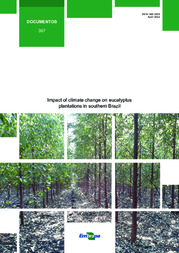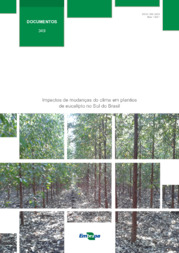The survey analyzes the most realistic climate change scenario for southern Brazil and part of São Paulo. Out of three areas analyzed in detail, two may experience slight changes in productivity while the other will be more impacted, but all were considered adapted for eucalyptus production over the next 30 years. Even with less impact, it is important to invest in research to mitigate and adapt to climate change. This is the first study to conduct this analysis on a ten-year instead of thirty-year time scale. Eucalyptus is most common tree genus planted by Brazilian forest-based industry. This research was a partnership between Embrapa and the Klabin company. A study by Embrapa researchers in three areas covering southern Brazil and part of São Paulo shows that if projected climate change scenarios actually materialize, productivity and the capacity to store carbon in cultivated eucalyptus forests will be altered in two regions. Even so, they will still be suitable for cultivating this species, and one area may experience little impact on productivity. Carbon emissions and removal capacity in soils where eucalyptus is planted was also analyzed; the sites in Paraná and Santa Catarina exhibited less intense future climate changes that could affect eucalyptus production. This research was carried out with support from the Klabin company. The study used data from the HADGEM2-ES model (considered the most up-to-date projection of climate change) and is the first to utilize a ten-year time scale compared to the intervals of 30 years used for predictions in previous studies. According to Eduardo Assad of Embrapa Digital Agriculture and Josiléia Zanatta of Embrapa Forestry, the researchers who led the study, the goal was to help guide planning for Brazilian forestry and scientific research efforts to mitigate and adapt to possible impacts. “The productive potential of eucalyptus plantations, especially in Brazil, is much higher than other regions of the globe, with few exceptions. For this reason, analyzing climate change and species impact projections have become strategic tools for the forest-based sector,” says Assad. Data were compiled from three eucalyptus growing regions: Itapetininga (São Paulo), Telêmaco Borba (Paraná), and Otacílio Costa (Santa Catarina). These regions not only have traditionally cultivated eucalyptus, but also had consistent historical climate data series available. “The ideal period for study modeling should cover a series with at least 30 years of data and be updated to the present time. We utilized climate series from 1980 to 2010,” Assad explains. Meteorological variables that affect the growth, development, and productivity of eucalyptus such as rain, air temperature, evapotranspiration, and water deficit were analyzed. The main climate risks evaluated that could impact eucalyptus cultivation were quantity and frequency of intense drought, minimum temperature and frost, average temperature, potential evapotranspiration, and water deficit. By adopting the Climate Risk Zoning methodology, the changes projected with such variables were linked to the amount of water that meets demand from this crop (technically known as the water requirement satisfaction index) and to soil characteristics. With this information, possible changes in forest productivity and carbon (plant biomass) could be predicted for future periods from 2025 to 2035. HADGEM2-ES model The future scenarios used in this study were generated by the HadGEM2-ES model using the RCP 8.5 projection model, which is the most extreme scenario out of those indicated by the IPCC. Considering the current flow of CO2 emissions, however, this is the most realistic scenario in terms of global warming. The model was supplied with information from the time series and simulated the future behavior of climate variables. The uses of eucalyptus Eucalyptus is the most widely planted forest genus in Brazil, supplying the raw materials for a wide range of economic sectors such as paper/cardboard/packaging, cellulose, furniture, civil construction, resins, and bioproducts while also generating energy for agriculture and steel production. Main conclusions The study analyzed the conditions for cultivation and impact on productivity, as well as the potential for forests to accumulate carbon in biomass and soil. The projections indicate that temperature and water deficit will increase in Telêmaco Borba and Otacílio Costa, but water deficit will remain below approximately 200 mm/year, which does not impact eucalyptus productivity. On the other hand, in Itapetininga, growth in water deficit is projected, which could affect productivity; for this reason, the region is classified as medium to high climate risk in the future. Another conclusion is that water deficit is not a limiting factor for eucalyptus production, except for the regions that straddle the border between the states of Paraná and São Paulo, which during 2021–2040 may experience a reduction in rainfall exceeding 300 mm/year. “This classification indicates that investments as well as research efforts should be directed toward eucalyptus cultivation; we can see this happening in the forest-based sector, but they need to be increasingly stimulated and coordinated,” says José Totti, Director of Forestry at Klabin, a company that collaborated in the research project. “Brazil is considered a leader in eucalyptus forestry, developing state-of-the-art technology, and this should be seen as yet another opportunity for companies, universities, and research centers to continue developing technologies so that the country can maintain its global prominence. In fact, there is already a major joint effort to reduce risks, in developing new genetic material as well as techniques for silviculture and environmental management," adds Erich Schaitza, Head of Embrapa Forestry. “Spatial and temporal scale changes are strongly recommended in future analyses,” adds Assad. Importance of the forest sector According to data from the Brazilian Tree Industry (Ibá), the planted tree sector currently has 9 million hectares under cultivation, most notably with eucalyptus and pine. The sector is also responsible for conserving 5.9 million hectares in permanent preservation areas (PPA), legal reserves (LR), and private natural heritage reserves (PNHR). The area of influence spans over a thousand municipalities, generating 1.3 million jobs, with an income effect reaching 3.75 million people employed. Total gross revenues in 2019 totaled R$ 97.4 billion. Changes in carbon Since changes in the climate patterns studied affect the productivity of forest crops, they also affect the carbon stocks contained in the forest. This also affects planted forests' potential to remove carbon. “Some regions will be more impacted than others, and some environments or production sites may be more susceptible, depending on their characteristics," explains researcher Josiléia Zanatta. “It is also important to emphasize that losses should not be restricted to the carbon stored in plant biomass, since planted forests are transformed into forest products that can also be carbon drains for long periods, depending on what manufacturing process the wood is directed toward.” The study found that the regions studied will maintain their high potential for carbon accumulation. The projected climate change scenario will impact the amount of carbon sequestered by less than 10%, depending on the region. Again, Itapetininga will be more affected. “In Telêmaco Borba the losses will be small, and in Otacílio Costa this potential will not be negatively affected at all, considering the data and premises adopted in the study," emphasizes Zanatta. Despite the apparent resilience that the relative data indicate about the annual rate of carbon increment in the forest, the accumulated losses in absolute terms (less than 10%) are significant and could reach more than eight million tons of carbon in the analyzed region in 2035, representing a loss of 2.5% in the carbon stored in forests in the states of São Paulo, Santa Catarina, and Paraná. But because this area has potential for expansion, if the growth rate remains at current levels the region will account for approximately 320 million tons of carbon sequestered by eucalyptus forests in 2035, demonstrating the important contributions this region can make to environmental quality and climate change control policies. Another option for those investing in planted forests is the sale of carbon credits, since the region in the study accounts for almost 20% of Brazil’s area cultivated with eucalyptus. “This opportunity to commercialize forest carbon credits is also expected to benefit from the storage of carbon in the soil,” says Zanatta. The impact of planted forests on carbon stored in the soil depends much more on the previous use of this soil than on climatic conditions. “Since the region's forests have expanded already consolidated uses such as pasture and agriculture, an increase in carbon storage in the soil can be expected, increasing the environmental benefits of planted forests," she concludes. Actions for mitigation and adaptation in the forest sector The best strategies to protect forest plantations from the loss of production potential and consequently maintain their capacity to mitigate greenhouse gas emissions involve two main lines of research: genetic selection and improvement, and adapting management practices for lower risk impact. This can involve a variety of activities, such as: - identifying varieties that are more adapted (resistant/tolerant) to the effects of climate change such as increased concentrations of CO2, drought, and heat events. Molecular markers can be useful tools in these efforts. - landscape planning and situating plantations within land use mosaics for water conservation. - discovering and applying genetic, molecular, biochemical, and physiological mechanisms that help crops to adapt to these stressors. - researching genes that confer resistance and/or tolerance to climate change for adaptation, with biotechnological value. - researching and adapting crops to new pests and diseases that may present problems to plant health as a result of climate imbalance. - developing silvicultural practices that may become important to boost the resilience of forest crops, mainly resulting in more efficient use of resources such as water, light and nutrients. Brazil's international commitments and the potential of planted forests Planted forests can suffer from the consequences of climate change and also play an active role in mitigating the risks of these impacts, since they are important mechanisms of carbon sequestration. A 2015 study found that planted forests were responsible for removing and storing an average of approximately 1.1 gigatons of carbon each year around the world between 1991 and 2015. Since the signing of the International Convention on Climate Change in 1992, the role forests play in global climate change policy has evolved quickly and in complex ways, such as through the Kyoto Protocol commitments, nationally appropriate mitigation actions, the REDD+ mechanism, and even the Paris Agreement. The actions implemented by Brazil include the National Plan for Planted Forests, which was published in late 2017 and includes a goal to expand forest plantations by 2 million hectares, as well as the ABC Plan, which encourages and finances practices such as planting directly into untilled post-harvest fields, various production systems involving integration of crops, livestock, and forests, agroforestry systems, reforestation, and biological nitrogen fixation. The ABC Plan is ongoing, with discussions about its continuity and improvement with the ABC+ Plan, and is expected to align itself with the National Plan for Planted Forests in order to make it possible to increase the area of forest plantations in Brazil. The actions presented by Brazil in the Paris Agreement, which is a treaty within the scope of the United Nations Framework Convention on Climate Change to reduce greenhouse gas emissions from 2020 in order to keep global warming below 2°C, include expansion and recovery of 12 million hectares of forests by 2030.
Photo: Rodolfo Buhrer
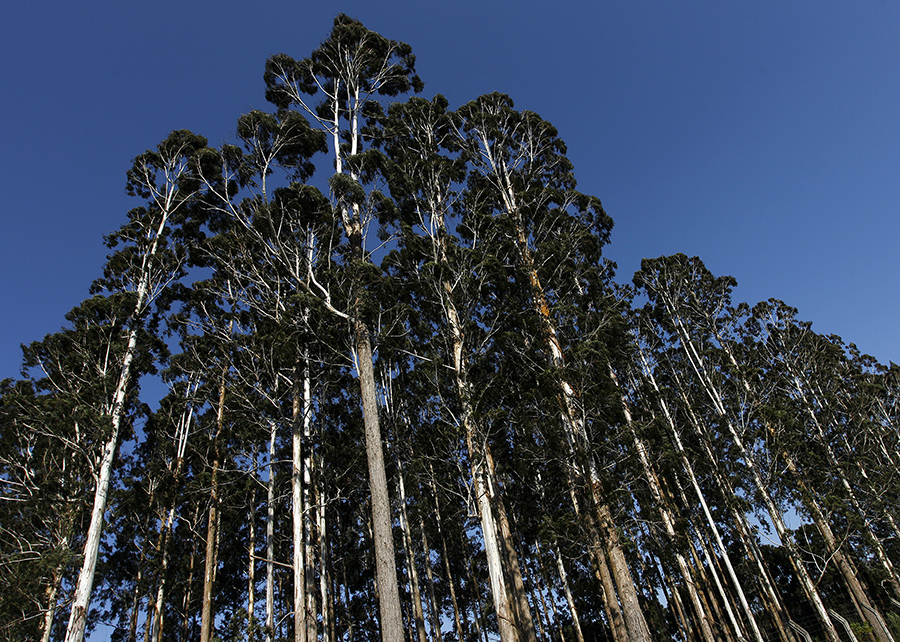
Impactos das mudanças climáticas em três áreas de cultivo de eucaliptos foram estudados
-
The survey analyzes the most realistic climate change scenario for southern Brazil and part of São Paulo. -
Out of three areas analyzed in detail, two may experience slight changes in productivity while the other will be more impacted, but all were considered adapted for eucalyptus production over the next 30 years. -
Even with less impact, it is important to invest in research to mitigate and adapt to climate change. -
This is the first study to conduct this analysis on a ten-year instead of thirty-year time scale. -
Eucalyptus is most common tree genus planted by Brazilian forest-based industry. -
This research was a partnership between Embrapa and the Klabin company. |
A study by Embrapa researchers in three areas covering southern Brazil and part of São Paulo shows that if projected climate change scenarios actually materialize, productivity and the capacity to store carbon in cultivated eucalyptus forests will be altered in two regions. Even so, they will still be suitable for cultivating this species, and one area may experience little impact on productivity.
Carbon emissions and removal capacity in soils where eucalyptus is planted was also analyzed; the sites in Paraná and Santa Catarina exhibited less intense future climate changes that could affect eucalyptus production. This research was carried out with support from the Klabin company.
The study used data from the HADGEM2-ES model (considered the most up-to-date projection of climate change) and is the first to utilize a ten-year time scale compared to the intervals of 30 years used for predictions in previous studies. According to Eduardo Assad of Embrapa Digital Agriculture and Josiléia Zanatta of Embrapa Forestry, the researchers who led the study, the goal was to help guide planning for Brazilian forestry and scientific research efforts to mitigate and adapt to possible impacts. “The productive potential of eucalyptus plantations, especially in Brazil, is much higher than other regions of the globe, with few exceptions. For this reason, analyzing climate change and species impact projections have become strategic tools for the forest-based sector,” says Assad.
Data were compiled from three eucalyptus growing regions: Itapetininga (São Paulo), Telêmaco Borba (Paraná), and Otacílio Costa (Santa Catarina). These regions not only have traditionally cultivated eucalyptus, but also had consistent historical climate data series available. “The ideal period for study modeling should cover a series with at least 30 years of data and be updated to the present time. We utilized climate series from 1980 to 2010,” Assad explains.
Meteorological variables that affect the growth, development, and productivity of eucalyptus such as rain, air temperature, evapotranspiration, and water deficit were analyzed.
The main climate risks evaluated that could impact eucalyptus cultivation were quantity and frequency of intense drought, minimum temperature and frost, average temperature, potential evapotranspiration, and water deficit.
By adopting the Climate Risk Zoning methodology, the changes projected with such variables were linked to the amount of water that meets demand from this crop (technically known as the water requirement satisfaction index) and to soil characteristics. With this information, possible changes in forest productivity and carbon (plant biomass) could be predicted for future periods from 2025 to 2035.
HADGEM2-ES model The future scenarios used in this study were generated by the HadGEM2-ES model using the RCP 8.5 projection model, which is the most extreme scenario out of those indicated by the IPCC. Considering the current flow of CO2 emissions, however, this is the most realistic scenario in terms of global warming. The model was supplied with information from the time series and simulated the future behavior of climate variables. |

The uses of eucalyptus Eucalyptus is the most widely planted forest genus in Brazil, supplying the raw materials for a wide range of economic sectors such as paper/cardboard/packaging, cellulose, furniture, civil construction, resins, and bioproducts while also generating energy for agriculture and steel production. |
Main conclusions
The study analyzed the conditions for cultivation and impact on productivity, as well as the potential for forests to accumulate carbon in biomass and soil.
The projections indicate that temperature and water deficit will increase in Telêmaco Borba and Otacílio Costa, but water deficit will remain below approximately 200 mm/year, which does not impact eucalyptus productivity. On the other hand, in Itapetininga, growth in water deficit is projected, which could affect productivity; for this reason, the region is classified as medium to high climate risk in the future.
Another conclusion is that water deficit is not a limiting factor for eucalyptus production, except for the regions that straddle the border between the states of Paraná and São Paulo, which during 2021–2040 may experience a reduction in rainfall exceeding 300 mm/year.
“This classification indicates that investments as well as research efforts should be directed toward eucalyptus cultivation; we can see this happening in the forest-based sector, but they need to be increasingly stimulated and coordinated,” says José Totti, Director of Forestry at Klabin, a company that collaborated in the research project. “Brazil is considered a leader in eucalyptus forestry, developing state-of-the-art technology, and this should be seen as yet another opportunity for companies, universities, and research centers to continue developing technologies so that the country can maintain its global prominence. In fact, there is already a major joint effort to reduce risks, in developing new genetic material as well as techniques for silviculture and environmental management," adds Erich Schaitza, Head of Embrapa Forestry. “Spatial and temporal scale changes are strongly recommended in future analyses,” adds Assad.
Importance of the forest sector According to data from the Brazilian Tree Industry (Ibá), the planted tree sector currently has 9 million hectares under cultivation, most notably with eucalyptus and pine. The sector is also responsible for conserving 5.9 million hectares in permanent preservation areas (PPA), legal reserves (LR), and private natural heritage reserves (PNHR). The area of influence spans over a thousand municipalities, generating 1.3 million jobs, with an income effect reaching 3.75 million people employed. Total gross revenues in 2019 totaled R$ 97.4 billion. |
Changes in carbon
Since changes in the climate patterns studied affect the productivity of forest crops, they also affect the carbon stocks contained in the forest. This also affects planted forests' potential to remove carbon.
“Some regions will be more impacted than others, and some environments or production sites may be more susceptible, depending on their characteristics," explains researcher Josiléia Zanatta. “It is also important to emphasize that losses should not be restricted to the carbon stored in plant biomass, since planted forests are transformed into forest products that can also be carbon drains for long periods, depending on what manufacturing process the wood is directed toward.”
The study found that the regions studied will maintain their high potential for carbon accumulation. The projected climate change scenario will impact the amount of carbon sequestered by less than 10%, depending on the region. Again, Itapetininga will be more affected. “In Telêmaco Borba the losses will be small, and in Otacílio Costa this potential will not be negatively affected at all, considering the data and premises adopted in the study," emphasizes Zanatta.
Despite the apparent resilience that the relative data indicate about the annual rate of carbon increment in the forest, the accumulated losses in absolute terms (less than 10%) are significant and could reach more than eight million tons of carbon in the analyzed region in 2035, representing a loss of 2.5% in the carbon stored in forests in the states of São Paulo, Santa Catarina, and Paraná.
But because this area has potential for expansion, if the growth rate remains at current levels the region will account for approximately 320 million tons of carbon sequestered by eucalyptus forests in 2035, demonstrating the important contributions this region can make to environmental quality and climate change control policies.
Another option for those investing in planted forests is the sale of carbon credits, since the region in the study accounts for almost 20% of Brazil’s area cultivated with eucalyptus. “This opportunity to commercialize forest carbon credits is also expected to benefit from the storage of carbon in the soil,” says Zanatta.
The impact of planted forests on carbon stored in the soil depends much more on the previous use of this soil than on climatic conditions. “Since the region's forests have expanded already consolidated uses such as pasture and agriculture, an increase in carbon storage in the soil can be expected, increasing the environmental benefits of planted forests," she concludes.
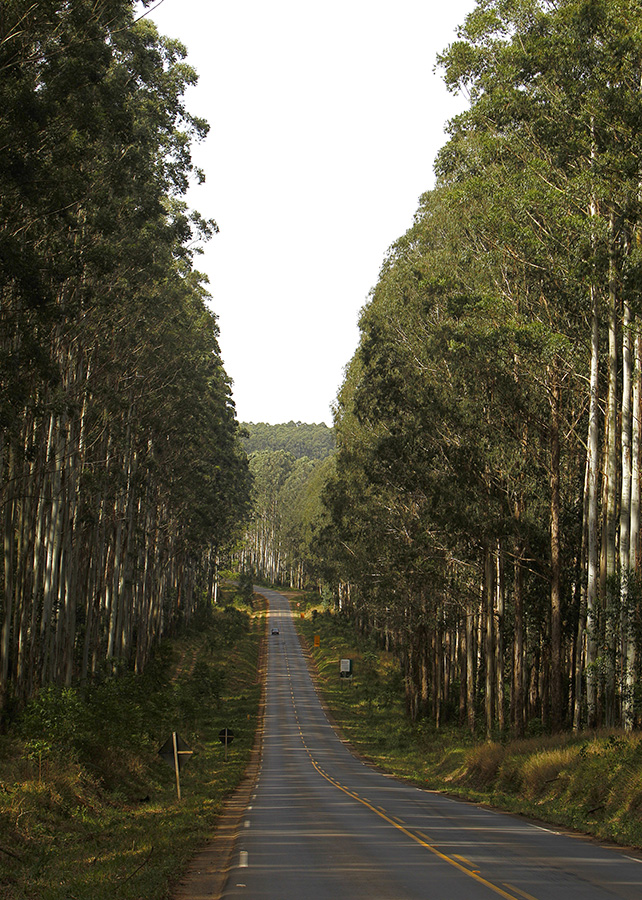
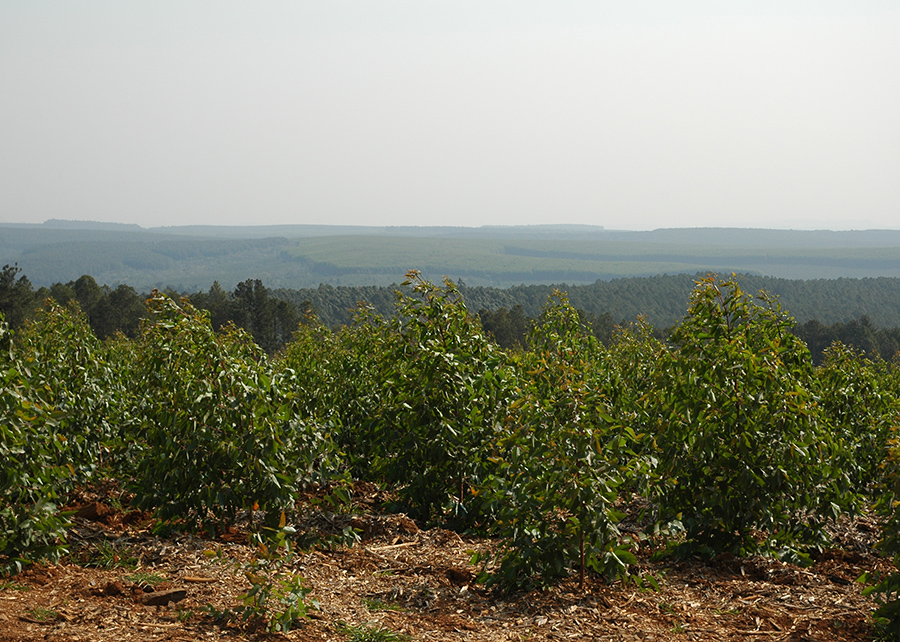 Actions for mitigation and adaptation in the forest sector Actions for mitigation and adaptation in the forest sector
The best strategies to protect forest plantations from the loss of production potential and consequently maintain their capacity to mitigate greenhouse gas emissions involve two main lines of research: genetic selection and improvement, and adapting management practices for lower risk impact. This can involve a variety of activities, such as: 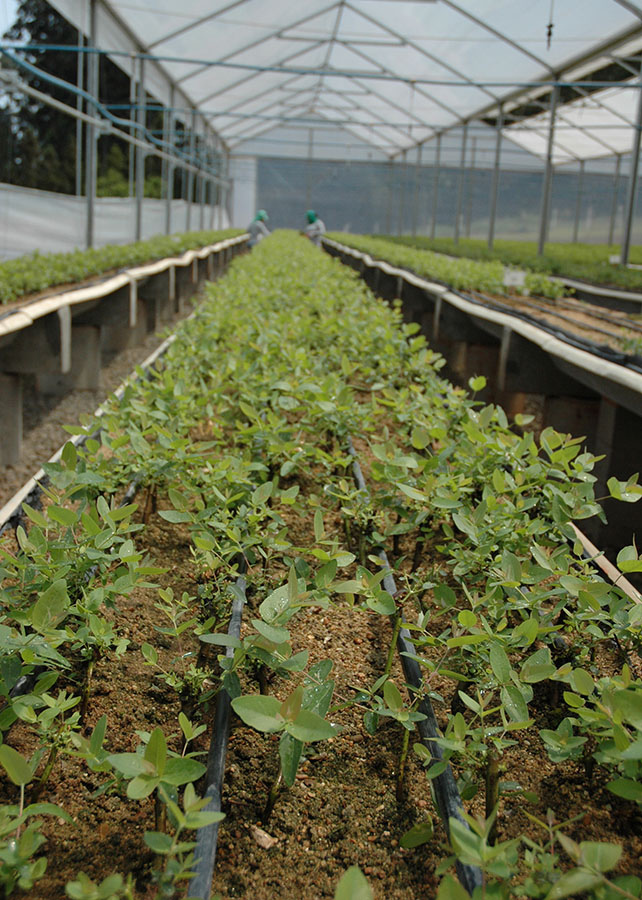
- identifying varieties that are more adapted (resistant/tolerant) to the effects of climate change such as increased concentrations of CO2, drought, and heat events. Molecular markers can be useful tools in these efforts. - landscape planning and situating plantations within land use mosaics for water conservation. - discovering and applying genetic, molecular, biochemical, and physiological mechanisms that help crops to adapt to these stressors. - researching genes that confer resistance and/or tolerance to climate change for adaptation, with biotechnological value. - researching and adapting crops to new pests and diseases that may present problems to plant health as a result of climate imbalance. - developing silvicultural practices that may become important to boost the resilience of forest crops, mainly resulting in more efficient use of resources such as water, light and nutrients. |
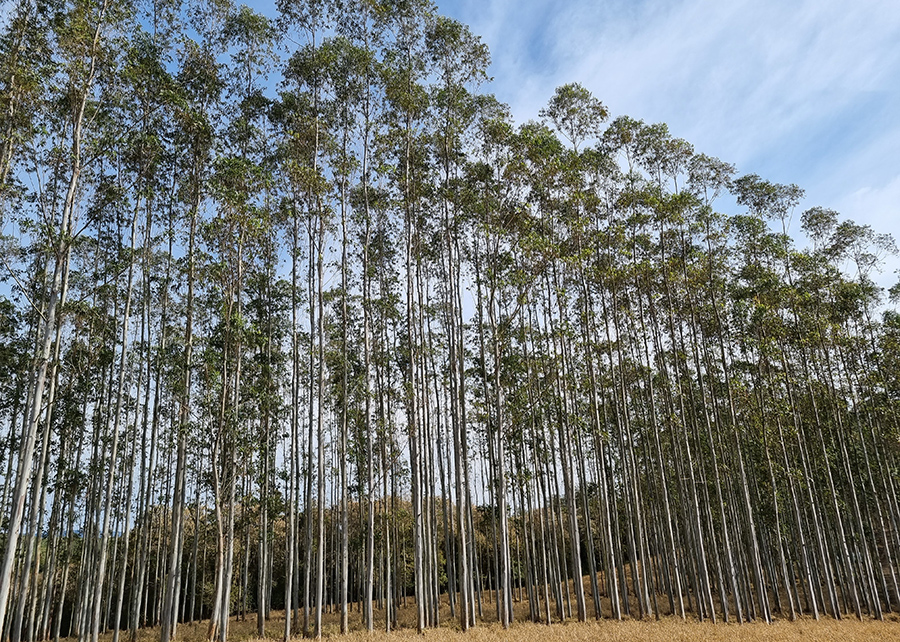 Brazil's international commitments and the potential of planted forests Brazil's international commitments and the potential of planted forests
Planted forests can suffer from the consequences of climate change and also play an active role in mitigating the risks of these impacts, since they are important mechanisms of carbon sequestration. A 2015 study found that planted forests were responsible for removing and storing an average of approximately 1.1 gigatons of carbon each year around the world between 1991 and 2015. Since the signing of the International Convention on Climate Change in 1992, the role forests play in global climate change policy has evolved quickly and in complex ways, such as through the Kyoto Protocol commitments, nationally appropriate mitigation actions, the REDD+ mechanism, and even the Paris Agreement. The actions implemented by Brazil include the National Plan for Planted Forests, which was published in late 2017 and includes a goal to expand forest plantations by 2 million hectares, as well as the ABC Plan, which encourages and finances practices such as planting directly into untilled post-harvest fields, various production systems involving integration of crops, livestock, and forests, agroforestry systems, reforestation, and biological nitrogen fixation. The ABC Plan is ongoing, with discussions about its continuity and improvement with the ABC+ Plan, and is expected to align itself with the National Plan for Planted Forests in order to make it possible to increase the area of forest plantations in Brazil. The actions presented by Brazil in the Paris Agreement, which is a treaty within the scope of the United Nations Framework Convention on Climate Change to reduce greenhouse gas emissions from 2020 in order to keep global warming below 2°C, include expansion and recovery of 12 million hectares of forests by 2030. |
Katia Pichelli (MTb 3594/PR)
Embrapa Forestry
Press inquiries
florestas.imprensa@embrapa.br
Phone number: +55 41 99977-5787
Natália Favero
Klabin
Press inquiries
Phone number: +55 11 94192-1593
Further information on the topic
Citizen Attention Service (SAC)
www.embrapa.br/contact-us/sac/


